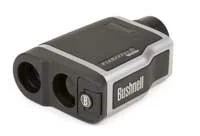The Binocular Site
Hitting a Hole-in-one with Rangefinders
 Rangefinders are familiar to those who do construction surveying, as they allow people to estimate distances while building roads, bridges, railways, and more.
Rangefinders are familiar to those who do construction surveying, as they allow people to estimate distances while building roads, bridges, railways, and more.
However, most often rangefinders are used in one of two activities – golf and hunting. Whether you’re trying to make the perfect hole-in-one, or accurately track game, there is a rangefinder for you.
There are two main ways rangefinders can work to measure distances. The first method, available since the early 1900’s, involves using trigonometry.
These rangefinders are known as stadiametric, parallax, or coincidence rangefinders.
A more modern method involves actively sending out signals and measuring the time taken for them to bounce back and be read by the finder. Methods used here include sonar, laser, and radar. Glass and prisms are used along with fine measurement units to allow for distance estimation.
Pinseeking And Scan Modes
Rangefinders are largely listed as “pinseekers”. This label seems misleading, since it refers to how rangefinders can be used to seek out a distant object. All rangefinders will be able to do so. However, some rangefinders have other modes available, such as scan mode.
When in scan mode, rangefinders can be used to search at a distance for a moving object and then follow it. Some models have an automatic shut-off to the scan mode, as it can be quite draining of batteries, and this will help preserve energy. Consider carrying extra sets and rechargeable batteries along with a charger if your rangefinder has scan mode available.
Other modes are available on some units, such as rain mode for use in poor weather, however others suggest these modes are not necessary.
Sizes And Styles
Rangefinders come in a wide array of sizes, styles, and orientations. While many consist of two barrels horizontally placed together, others have barrels one atop the other for a more vertical look. Some laser ranges are mounted, others are used by hand. Finally, some offer very minimal magnification, however typically they are used for measuring distances but not viewing objects.
There are rangefinders consisting only of one barrel as well, making these more portable and easier to use while following movement at a moment’s notice. Whether you choose a dual barrel or single barrel design is largely a personal preference. While double barrels can be more expensive, they offer a more natural “stereo” version of images that may be more comfortable for the eyes.
Perhaps most interesting about rangefinders is just how many sizes and shapes they come in. As mentioned above, they are most used while golfing and during hunting, so are sized, shaped, and mounted accordingly. Several very small rangefinders are available to be mounted on pistols, whereas mounts also exist to secure your rangefinder to your golfbag.
Larger models can easily work with tripods but are not restricted to doing so, whereas other models are optimally sized for being held in hand. Camouflage covered rangefinders are available as are very small versions such as Bushnell’s 5x20 Golf Scope Rangefinder Monocular. Whereas Nikon’s Callaway Golf Rangefinder LR550 is waterproof, fast, and simple to use, Barska has several models with built-in compasses.
Although objective lens size and magnification are not as variable with rangefinders, you are able to choose from a wide range of price points, styles, and extras to get exactly what you need.
Weather And Water Proofing
Waterproofing, fog-proofing, and rainguard coatings are often available with rangefinders, to help keep them working optimally and protect them from damage regardless of your environment.
Most models have a sleek exterior with rubber grips molded for easy hand-holding along with hard shells, and tethers are often available to keep rangefinders close at hand and easy to find.
Carrying cases and straps may be included, battery types vary, and measurement methods do as well. Consider your preferences carefully while shopping for rangefinders

